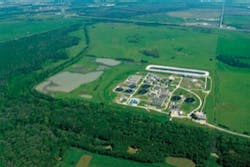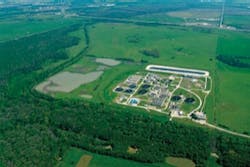RICHLAND, WA, Sept. 10, 2009 -- Workers at the U.S. Department of Energy's Hanford Site have finished removing a nuclear reactor basin that was once considered a top environmental risk at the government site in Washington State that produced plutonium for national defense programs from the 1940s to the 1980s.
Contractor CH2M HILL Plateau Remediation Company finished excavating the K East Basin on Sept. 9, meeting an important milestone in the regulatory agreement governing Hanford cleanup, the Tri-Party Agreement. Removing the facility will allow workers to access soil underneath the basin that had been contaminated by leaks of water from the basin in the 1970s and 1990s. The basin is located adjacent to the K East Reactor, one of nine plutonium production reactors along the Columbia River on the Hanford Site.
"Getting this nuclear reactor basin out of the ground is another important step in protecting the Columbia River and the more than one million people who live downriver," said Dave Brockman, Manager of the Department of Energy's Richland Operations Office. "This also brings us one step closer to shrinking the footprint of Hanford cleanup to less than 75 square miles in the center of the Site by 2015."
The 1.2-million-gallon basin once held 1,100 tons of uranium metal fuel rods, known as spent nuclear fuel, leftover from Hanford reactors after plutonium processing ended, as well as sludge, a byproduct of fuel corrosion during years of storage. The highly radioactive spent fuel and less radioactive sludge were stored in 20 feet of water that provided shielding.
Workers finished removing the spent nuclear fuel from the basin in 2004 and the sludge in 2007. Water was drained from the basin in 2008 and the facility was filled with 5,100 cubic yards of sand mixed with grout. The sand provided shielding from radioactivity in the basin's concrete walls and was a platform for the heavy machinery that demolished the basin's superstructure in 2008.
Between October 2008 and September 2009, workers filled more than 2,000 large containers with debris as they excavated the basin that was 20 feet deep, 125 feet long and 67 feet wide. The waste was disposed of in the lined, engineered disposal facility on the Hanford Site for low-level waste, the Environmental Restoration Disposal Facility.RL-09-0024
"This is a significant accomplishment that involved hazardous material," said John Lehew, President of CH2M HILL Plateau Remediation Company. "Our highly skilled workers are to be commended for completing it safely."
Commitments under the Tri-Party Agreement among the DOE, Washington State Department of Ecology and Environmental Protection Agency (EPA) call for DOE to finish removing the basin by Sept. 30. The next milestone for work on the project calls for starting remediation of soil underneath the basin. Contractor CH2M HILL will begin that work immediately to remove radioactive and hazardous material contaminants from the soils to further reduce the risk of contamination reaching the nearby Columbia River.
###




